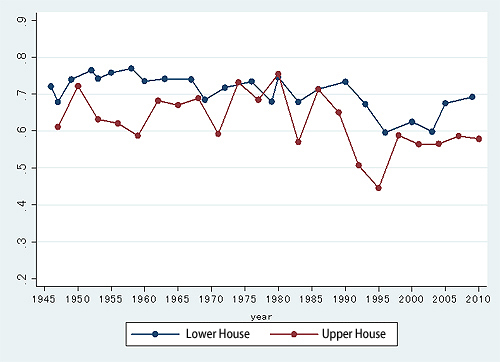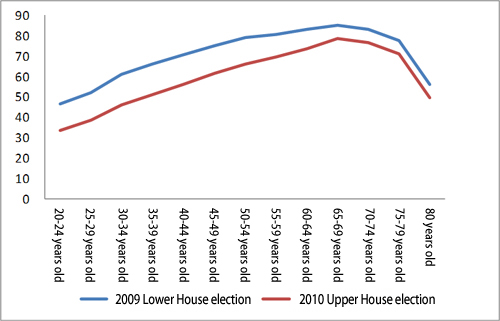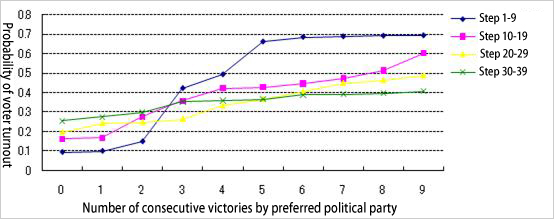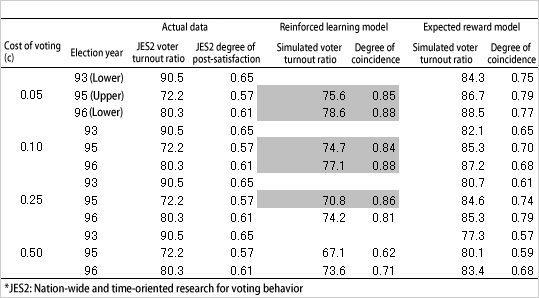Top>Research>Why do voters go to the polls? Utility, Sense of duty, or Learning?
 Index
Index

Kiichiro Arai [Profile]
Education Course
Why do voters go to the polls? Utility, Sense of duty, or Learning?
Kiichiro Arai
Assistant Professor of Political Psychology and Political Behavior,Faculty of Policy Studies, Chuo University
Decreasing voter turnout?
In Japan and other countries which have adopted a parliamentary democracy, voters select representatives through an election. The elected representatives then form a parliament and make political decisions. Accordingly, the legitimacy of parliament members that represent voters and the legitimacy of the parliament which is composed of members are both secured by reflecting public opinion. This legitimacy is undermined when many voters abstain from voting or when only certain voters go to the polls. Since the 1990s, it has been said that voters in Japan feel political apathy. Evidence offered for this statement includes the increase of voters with no affiliation to a particular political party, as well as by a decreased voter turnout for national elections. There is particular concern regarding marked political apathy among young voters. Indeed, data shows that the voter turnout for national elections after WWII decreased significantly in the 1990s for both the Lower House and Upper House of parliament. However, voter turnout began to increase again upon entering the 2000s and now remains constant between approximately 60% and 80% (Figure 1). Moreover, when examining voter turnout by age group for the most recent national election, it is true that turnout by voters in their 20s is lower than any other age group. Even so, nearly half of all voters participated in the election for the Lower House (Figure 2).
Figure 1: Voter turnout in national elections after WWII

Source: The Association for Promoting Fair Elections
Figure 2: Voter turnout by age group for the 2009 Lower House election and the 2010 Upper House election

Source: The Association for Promoting Fair Elections
As stated above, voter participation fulfills the function of inputting the preferences of voters who are the constituents of a certain political system. Moreover, voter participation is a prerequisite for the formation of modern democracy. Therefore, normatively speaking, it is preferable for voter turnout to be as high as possible. A low voter turnout among young people means that it is increasingly difficult to reflect the opinion of the youth in parliament. It is only natural to view this situation as requiring reform.
However, the majority of political scholars, whose job is to scientifically assess political phenomenon, do not seek the answer as to why many voters (particularly young voters) abstain from voting. Instead, such scholars are more concerned with why 60% to 80% of voters actually vote in elections.
The paradox of voter turnout
"Who votes in elections and why?"-Answering this question clarifies the type of input for that political system. Both domestically and overseas, political science has used a variety of approaches in an attempt to explain voter turnout. I would like to introduce the Riker and Ordeshook model, which is one of the most famous models in research of voter turnout. This voter turnout model is expressed in the formula shown below.
R=P×B-C+D
In the above formula, R represents the reward gained by the individual voter from voting in a given election. B equals the difference in reward for when the voter's most preferred candidate wins and when the voter's least preferred candidate wins. P is the subjective probability of the voter receiving B as a result of the vote. C represents the cost incurred by the voter when voting. Finally, D represents the sense of responsibility as a citizen (duty) and the long-term benefit of maintaining a democratic system (democracy). Therefore, in this model, a voter will participate in the election when the value for R is greater than zero and will abstain from voting when the value is less than zero. In other words, a voter will go to the polls if it seems that a reward can be gained from voting, and will abstain from voting if no reward is apparent.
The behavioral principle in which a person selects the item which provides the greatest rewards was a principle of homo economicus in the field of micro economics. In political science, this principle is referred to as rational choice theory and is one of the most effective approaches in modern political science. I am sure that most of my readers feel very natural about the assumption of human beings acting based on a calculation of profit and loss. However, the actual consequence of the Riker and Ordeshook model is that there is a greater chance of abstaining from voting the more that the voter is rational and capable of accurately calculating his or her own reward. The reason is that the probability (expressed by P in the model) of one's single vote having an effect on the election is extremely small. This means that the cost (C) is greater than the reward gained from the election results (P×B). In most cases, this results in a negative value for R. Under the assumption that the voter will select the behavior which maximizes personal reward, the reward gained by abstaining from voting grows larger as the scale of the constituency increases. This brings us to a discussion of D. It is obvious that the concept of a voter who feels responsibility towards the act of voting is widely separated from the image of a voter who seeks to maximize personal reward as proposed in the rational choice theory. Even when D is considered as the long-term reward brought by maintaining a democracy, a voter will calculate the probability that a democratic system will be maintained due to his or her single votes. Of course, this probability is close to zero.
In other words, despite the fact that rational voters arrive at theoretical conclusion of abstaining from voting, more than half of possible voters participate in the majority of actual elections. This means that there is a disparity between the theoretical prediction and actual results. If voters truly decide whether or not to vote as shown by the model, then young voters are making a rational decision. This disparity between theory and reality is known as the paradox of voter turnout. Even today, more than 40 years after the proposal of the Riker and Ordeshook model, this paradox remains an important unsolved puzzle in political science. In the following section, I will introduce research which attempts to solve this puzzle from the perspective of learning by voters.
A new voter turnout model: Habitual participation by learning voters
Political scientists have used a variety of approaches in an attempt to clarify this paradox. In this section, I would like to introduce the model of reinforcement learning. In recent years, research regarding this model is being conducted in the fields of psychology and neuroscience. Bendor, Diermeier, and Ting (2003) are performing computer simulation by constructing a voter turnout model which uses the Bush-Mosteller model, one of the models for reinforcement learning in psychology. The Bush-Mosteller model shows the process in which a person decides his or her next action based on the result of previous actions when repeatedly engaging in some form of decision making. Figure 3 shows an overview of the voter turnout model constructed by Bendor, Diermeier, and Ting. In this model, a person does not predict the future and take actions which maximize reward. Instead, the model assumes that a person decides the next action by learning from the results of his or her previous actions. Simulations have shown that if voters select whether or not to vote based on this model, then the calculated voter turnout is close to the voter turnout of actual elections.
Figure 3: Voter turnout model through reinforcement learning

Source: Bendor et al. (2003); Fig.1 translated by author
Figure 4 shows a portion of results obtained when I made slight modifications to the Bendor model and conducted another computer simulation (*1). The graph shows the relationship between the probability of voter turnout by age group and the number of victories in subsequent elections by the political party supported by the voter. The "step" item of the graph represents the number of elections. For example, "Step 1-9" represents voters who have experienced from the first election to the ninth election, or young voters. The graph shows that the probability of voter turnout increases more for generations which experienced consecutive victories by their preferred party during their youth. It can also be seen that the effect of consecutive victories on the probability of voter turnout decreases as age increases. Moreover, the graph shows that older voters are more likely to continue participating in elections even if their preferred party does not win.
*1: The major difference with the Bendor model is that I introduced the concept of lifespan and had voters disappear from the model after repeating 40 elections.
Figure 4: Relationship between the probability of voter turnout and victories between one's preferred political party, viewed by age group (reinforcement learning model)

To continue, Table 1 was created through a simulation which was based on data from public polls and which used both the Riker and Ordeshook model for voter (expected utility model within table) turnout and the Bendor, Diermeier, and Ting model for voter turnout (reinforcement learning model within table). The table compares actual voter behavior with the simulated results for both models. The table shows that actual voter behavior conforms more to the reinforcement learning model than to the eexpected utility model.
Results of simulation based on survey data

Exploring mechanisms to overcome social dilemmas
Parliament and its members are granted with representativeness and legitimacy through elections because a majority of voters ignore costs and continue to participate in elections. This is nothing other than the public good of a democratic system. Therefore, clarification of the voting paradox means more than simply by unifying theory and reality. Indeed, it is clarification of the behavior mechanisms for human beings which compose society itself. Actually, it is possible to position the voting paradox as a form of more generalized social dilemma. In this context, social dilemma refers to the following condition: 1) a person is capable of choosing cooperation or non-cooperation in a certain situation, 2) for each person, the selection of non-cooperation yields a more beneficial result, and 3) the result of everyone selecting self-beneficial non-cooperation is worse than the result of everyone selecting cooperation. Despite the fact that voters are placed in a social dilemma during an election, the selection of cooperative action by the majority of voters supplies the public good of granting representativeness and legitimacy through elections.
In fields such as social psychology, a great amount of research has already been conducted in an attempt to use concepts such as reciprocity and social norms in order to explain human cooperative behavior in social dilemmas. However, there are also many phenomena which cannot be explained from these factors. It is difficult to explain voter turnout in elections using the concepts of reciprocity and social norms. The clarification of political participation mechanism will uncover new factors which explain human cooperative behavior in social dilemmas and will lead to the design of systems and policies for overcoming dilemmas.
Related Literature
- Arai, Kiichiro. 2010. Participation Mechanism-Dynamics of Citizens in Adaptation to Democracy. Doctoral thesis for the Waseda University Graduate School of Political Science.
- Bendor, J., D. Diermeier and M.Ting. 2003. "A Behavioral Model of Turnout." American Political Science Review 97(2):261-280.
- Dawes, R. M. 1980. "Social dilemmas." Annual Review of Psychology 31:169-193.
- Gerber, A. S., D. P. Green, and R. Shachar. 2003. "Voting May Be Habit-Forming: Evidence from a Randomized Field Experiment." American Journal of Political Science 47(3):540-550.
- Kanazawa, Satoshi. 1998. "A Possible Solution to the Paradox of Voter Turnout." The Journal of Politics 60(4): 974-995.
- Plutzer, E. 2002. "Becoming a Habitual Voter: Inertia, Resources, and Growth in Young Adulthood." American Political Science Review 96(1):41-56.
- Riker, W., and P. Ordeshook. 1968. "A theory of the calculus of voting." American Political Science Review 62:28-42.
- Kiichiro Arai
Assistant Professor of Political Psychology and Political Behavior,Faculty of Policy Studies, Chuo University - Born in Yokohama City in 1980. Graduated from the Chuo University Faculty of Policy Studies in 2004. In 2006, completed the Master's Program at the Waseda University Graduate School of Political Science. In 2009, completed the Doctoral at the Waseda University Graduate School of Political Science. Holds a PhD in political science. Assumed his current position in 2009 after serving as a Research Fellow of the Japan Society for the Promotion of Science. His current research themes include the construction of a political system for overcoming social dilemmas, clarification of the mechanism for generating majorities, and development of a computer-based system for surveying public opinion. His major written works include A mechanism of political participation: Experience and evaluation, Review of Electoral Studies No.6 (2006) and Attitude Stability affected by Political Sophistication, Japanese Journal of Electoral Studies Vol. 27 Issue No. 1 (2011; coauthored with Arata Yamazaki).
- Research Activities as a Member of Research Fellowship for Young Scientists (DC1), Japan Society for the Promotion of Science (JSPS) Shuma Tsurumi
- Important Factors for Innovation in Payment Services Nobuhiko Sugiura
- Beyond the Concepts of Fellow Citizens and Foreigners— To Achieve SDGs Goal 10 “Reduce Inequality Within and Among Countries” Rika Lee
- Diary of Struggles in Cambodia Fumie Fukuoka
- How Can We Measure Learning Ability?
—Analysis of a Competency Self-Assessment Questionnaire— Yu Saito / Yoko Neha - The Making of the Movie Kirakira Megane








